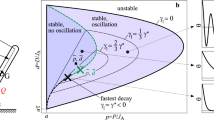Abstract
In this paper, we use a combination of numerical simulations, time series analysis, and complexity measures to investigate the dynamics of switched systems with noise, which are often used as models of human balance control during quiet standing. We link the results with complexity measures found in experimental data of human sway motion during quiet standing. The control model ensuring balance, which we use, is based on an act-and-wait control concept, that is, a human controller is switched on when a certain sway angle is reached. Otherwise, there is no active control present. Given a time series data, we determine how does it look a typical pattern of control strategy in our model system. We detect the switched nonlinearity in the system using a frequency analysis method in the absence of noise. We also analyse the effect of time delay on the existence of limit cycles in the system in the absence of noise. We perform the entropy and detrended fluctuation analyses in view of linking the switchings (and the dead zone) with the occurrences of complexity in the model system in the presence of noise. Finally, we perform the entropy and detrended fluctuation analyses on experimental data and link the results with numerical findings in our model example.












Similar content being viewed by others
References
Asai Y, Tasaka Y, Nomura K, Nomura T, Casadio M, and Morasso P (2009) A model of postural control in quiet standing: robust compensation of delay-induced instability using intermittent activation of feedback control. PLoS ONE 4(7):e6169
Costa M, Peng AG (2002) Multiscale entropy analysis of complex physiologic time series. Phys Rev Lett 89:068102 2372–2376
Duarte M, Sternad D (2008) Complexity of human postural control in young and older adults during prolonged standing. Exp Brain Res 191:265–276
Gawthorp P, Loram I, Lakie M, Gollee H (2011) Intermittent control: a computational theory of human control. Biol Cybern 104:31–51
Huang N, Wu Z, Long S, Arnold K, Chen X, Blank K (2009) On instantaneous frequency. Adv Adapt Data Anal 1:177–299
Ihlen E, Vereijken B (2010) Interaction dominant dynamics in human cognition: beyond 1/f fluctuations. J Exp Psychol Gen 139:436–463
Jeka J, Kiemel T, Creath R, Horak F, Peterka R (2004) Controlling human upright posture: velocity information is more accurate than position or acceleration. J Neurophysiol 92:2368–2379
Kiemel T, Oie KS, Jeka JJ (2002) Multisensory fusion and the stochastic structure of postural sway. Biol Cybern 87:262–277
Kloeden PE, Platen E (1995) Numerical solution of stochastic differential equations. Springer, Berlin
Kowalczyk P, Glendinning P, Brown M, Medrano-Cerda G, Dallali H, Shapiro J (2011) Modelling human balance using switched systems with linear feedback control. J R Soc Interface 9:234–245
Loram I, Maganaris C, Lakie M (2005) Active, non-spring-like muscle movements in human postural sway: how mightparadoxical changes in muscle length be produced. J Physiol 564:281–293
Marple S (1999) Computing the discrete-time analytic signal via FFT. IEEE Trans Signal Process 47:2600–2603
Maurer C, Peterka RJ (2005) A new interpretation of spontaneous sway measures based on a simple model of human postural control. J Neurophysiol 93:189–200
Peng C, Buldyrev S, Havlin S, Simons M, Stanley H, Goldberger A (1994) Mosaic organization of DNA nucleotides. Phys Rev E 49:1685
Peterka RJ, Loughlin PJ (2004) Dynamic regulation of sensorimotor integration in human postural control. J Neurophysiol 91:410–423
Richman J, Moorman J (2000) Physiological time-series analysis using approximate entropy and sample entropy. Am J Physiol Heart Circ Physiol 278:H2039–H2049
Winter DA, Patla AE, Riedtyk AE, Ishac M (2001) Ankle muscle stiffness in the control of balance during quiet standing. J Neurophysiol 85:2630–2633
Author information
Authors and Affiliations
Corresponding author
Rights and permissions
About this article
Cite this article
Nema, S., Kowalczyk, P. & Loram, I. Complexity and dynamics of switched human balance control during quiet standing. Biol Cybern 109, 469–478 (2015). https://doi.org/10.1007/s00422-015-0655-5
Received:
Accepted:
Published:
Issue Date:
DOI: https://doi.org/10.1007/s00422-015-0655-5




